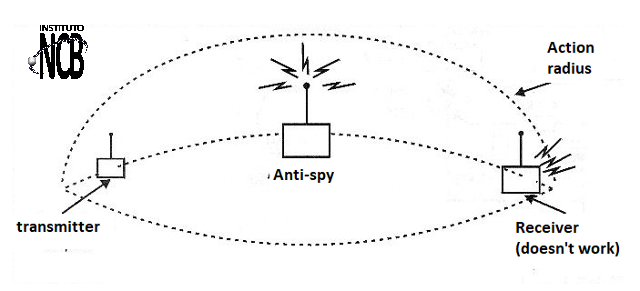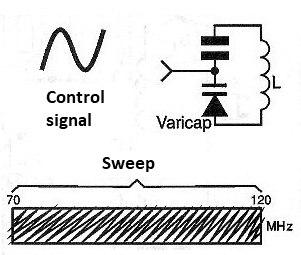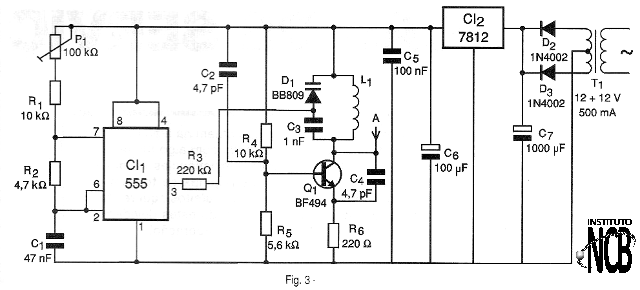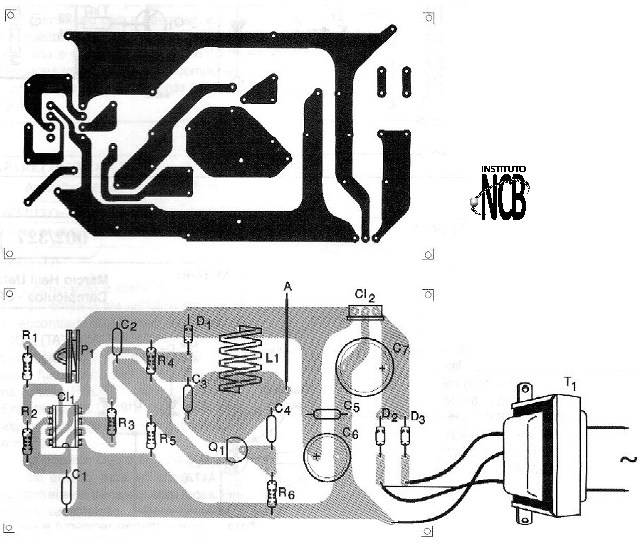Small FM transmitters for spying can be easily assembled or purchased. This means a great vulnerability of companies and even people who would easily have their conversations recorded, revealing secrets that would bring losses of several orders.
While a special receiver or field-strength meter can help detect a spy transmitter hidden in any office or meeting room, it is best to have some anti-spy device that hinders or prevents the operation of such a transmitter within a certain radius of action.
What we propose in this article is a noise-generating transmitter that covers the FM range and even part of the VHF range within a few tens of meters, preventing receivers from picking up signals from some small hidden transmitter. The noise generator circuit can be plugged into any outlet and prevent FM receiver operation in its vicinity, receivers that would be used to pick up the signals from secret transmitters, as Figure 1 suggests.

Of course, the power of such equipment can not and should not be increased as it would cause interference to receivers for the FM band, which is illegal. Thus, the use of such a transmitter is recommended only in the case of establishments that do not have nearby residences that could suffer interference in the TV and FM band.
HOW IT WORKS
An audio oscillator based on an integrated circuit 555 generates a tandem signal whose frequency can either be set at P1, or depends on C1. In our case, a frequency between 200 and 2000 Hz is convenient for the desired application.
The sawtooth signal controls the frequency of a transmitter acting on a varicap diode (D1). The varicap (or variable capacitance diode) diode has its capacitance dependent on the applied voltage. Since this diode is in the tuning circuit of a high frequency oscillator, the frequency of the transmitted signal constantly varies within a relatively wide range, as shown in Figure 2.

The width of the strip depends on the applied voltage. In our case, by making the circuit operate at a relatively high voltage, we can easily sweep the entire FM range and even part of the VHF range where some secret spy transmitter could operate.
The power, for reasons already explained, is limited by the type of transistor used and also by its polarization, basically by the emitter resistor. The antenna, also for reasons of power, can not be larger than about 40 to 80 cm.
ASSEMBLY
In figure 3 we have the complete diagram of the anti-spy transmitter.

The arrangement of the components on a printed circuit board is shown in figure 4.

The bobbin L1 is formed by 4 turns of yarn 22 to 26 without shape with a diameter of 1 cm. The capacitors must all be ceramic except C1 which can also be polyester.
The resistors are 1 / 8W and the transistor accepts equivalents as well as the varicap diode. Of course, the swept range will depend on the diode used.
TEST AND USE
Connect an FM receiver tuned to any station near the unit. Turn on the anti-spy transmitter. There should be a loud buzz covering the entire range and preventing the receiver from tuning stations. Set the buzzer to P1 according to the desired effect.
To use, simply leave the transmitter switched on in the conference room or in meetings where some spy transmitter is suspected.
Semiconductors:
CI-1 - 555 - integrated circuit, timer
CI-2 - 7812 - integrated circuit, voltage regulator
Q1 - BF494 or equivalent - RF NPN transistor
D1 - BB809 or equivalent - varicap diode
D2, D3 - 1N4002 - silicon rectifier diodes
Resistors: (1 / 8W, 5%)
R1, R4 - 10k ohm
R2 - 4.7 k ohm
R3 - 220 k ohm
R5 - 5.6 k ohm
R7 - 220 ohm
P1 - 100 k ohm
Capacitors:
C1 - 47 nF - polyester or ceramic
C2 - 4.7 nF - ceramic
C3-1 nF - ceramic
C4 - 4.7 pF - ceramic
C5 - 100 nF - ceramic
C6 - 100 ?F / 16 V - electrolytic
C7 - 1000 ?F / 25 V - electrolytic
Several:
L1 - Coil - see text
A - antenna - see text
T1 - Transformer with primary according to the local and secondary network of 12 + 12 V from 300 to 500 mA
Printed circuit board, mounting box, power cable, wires, solder, antenna, etc.




